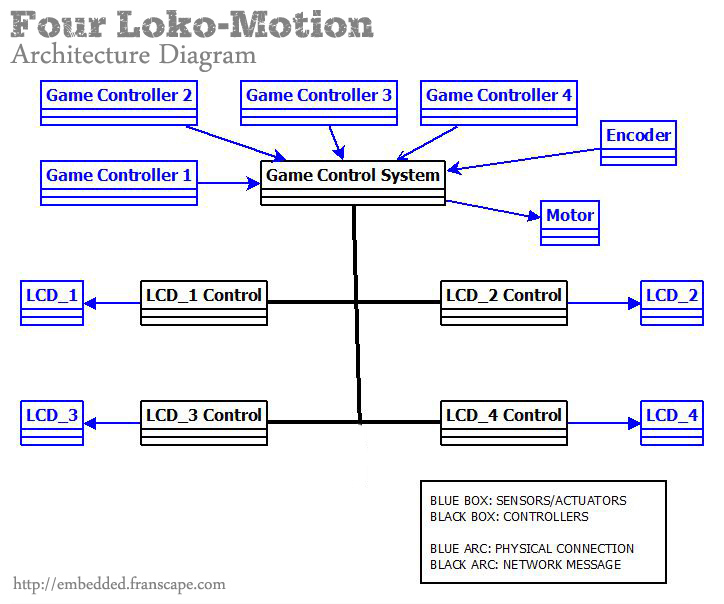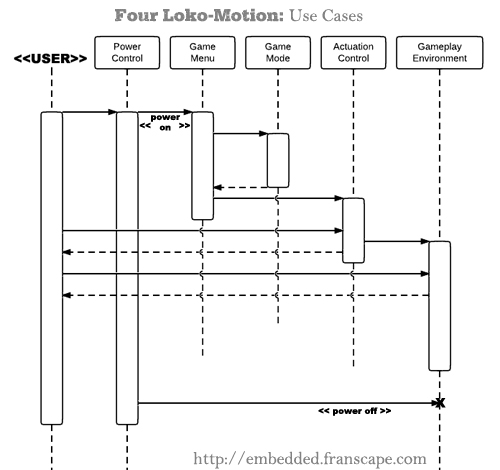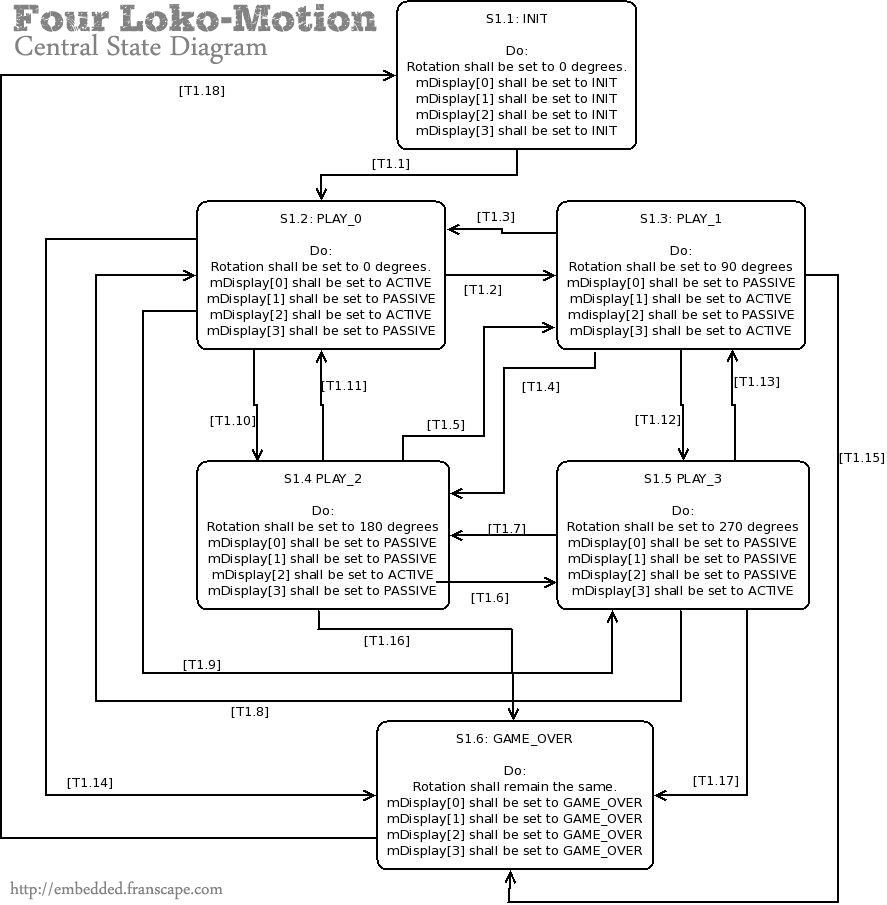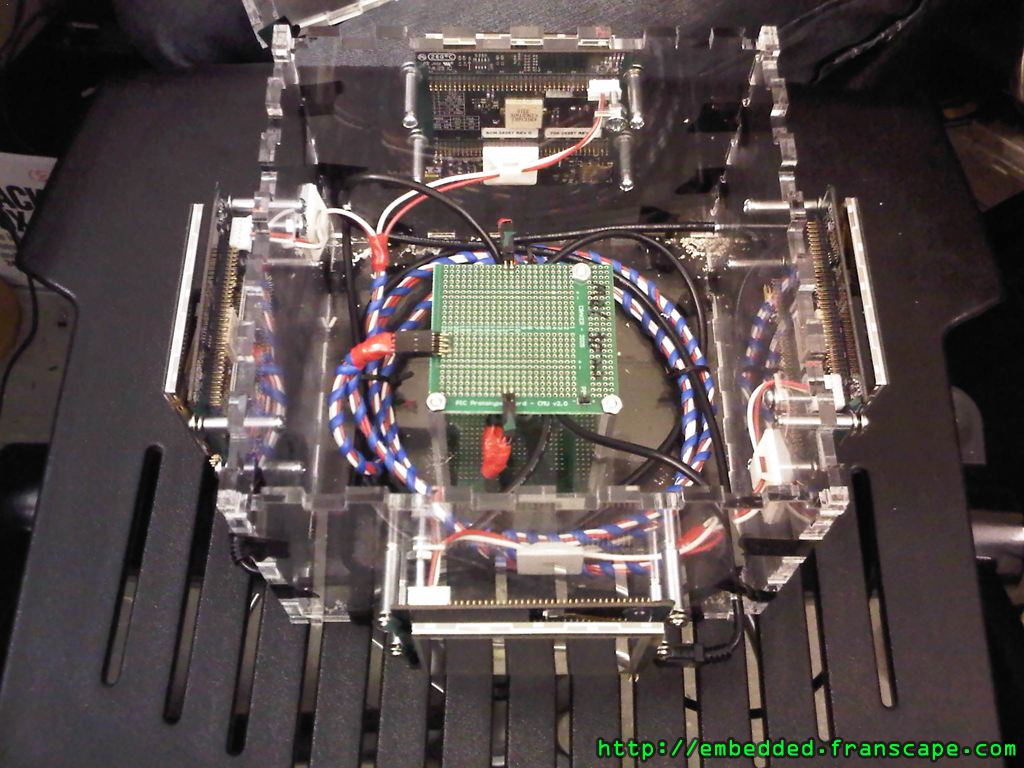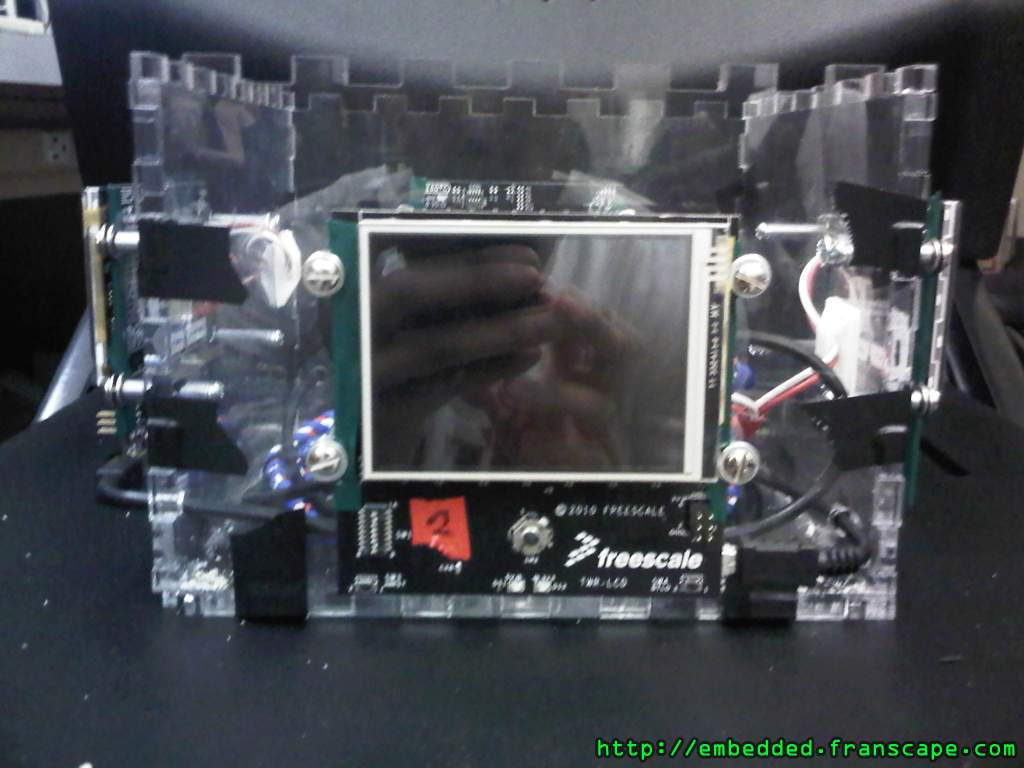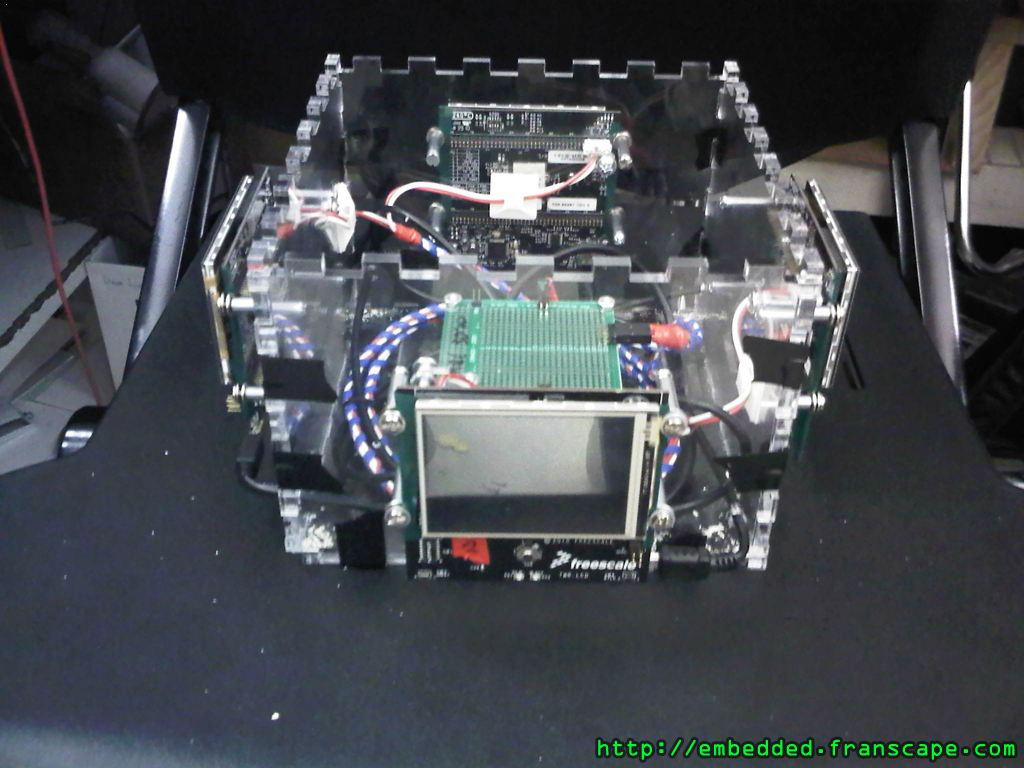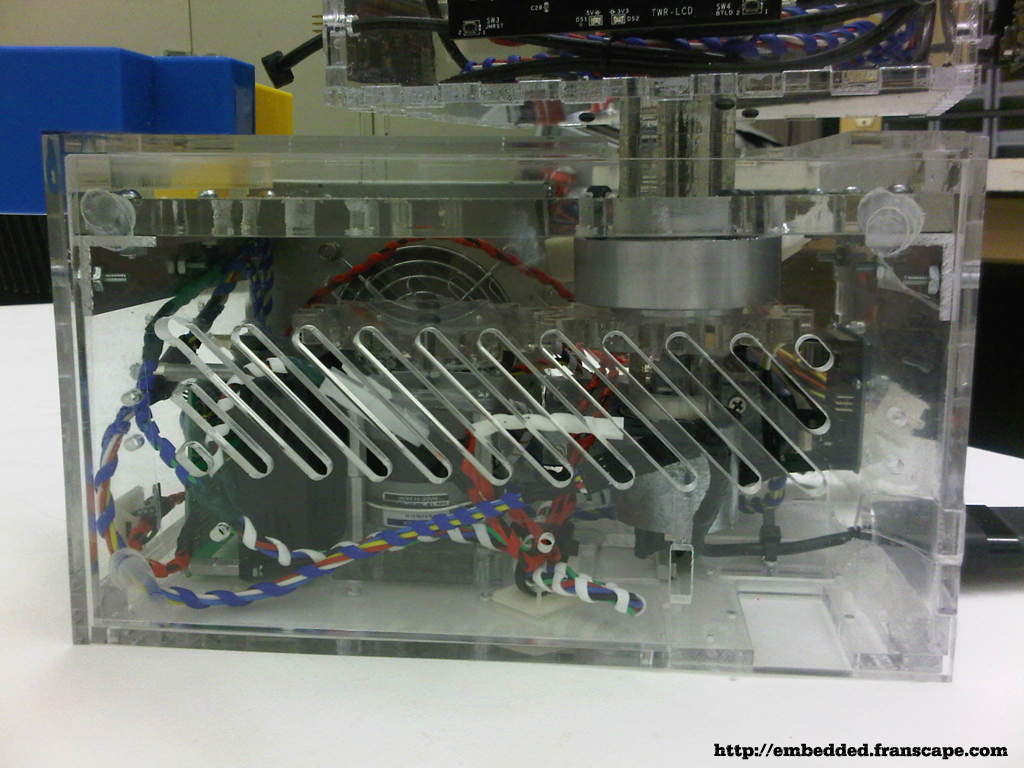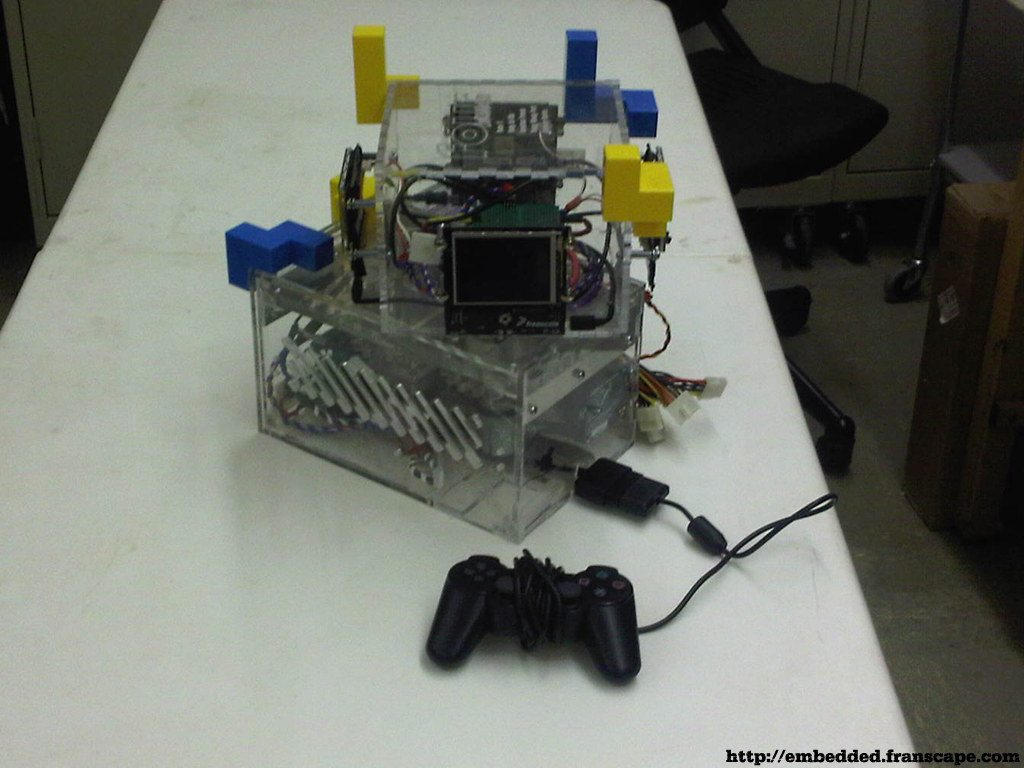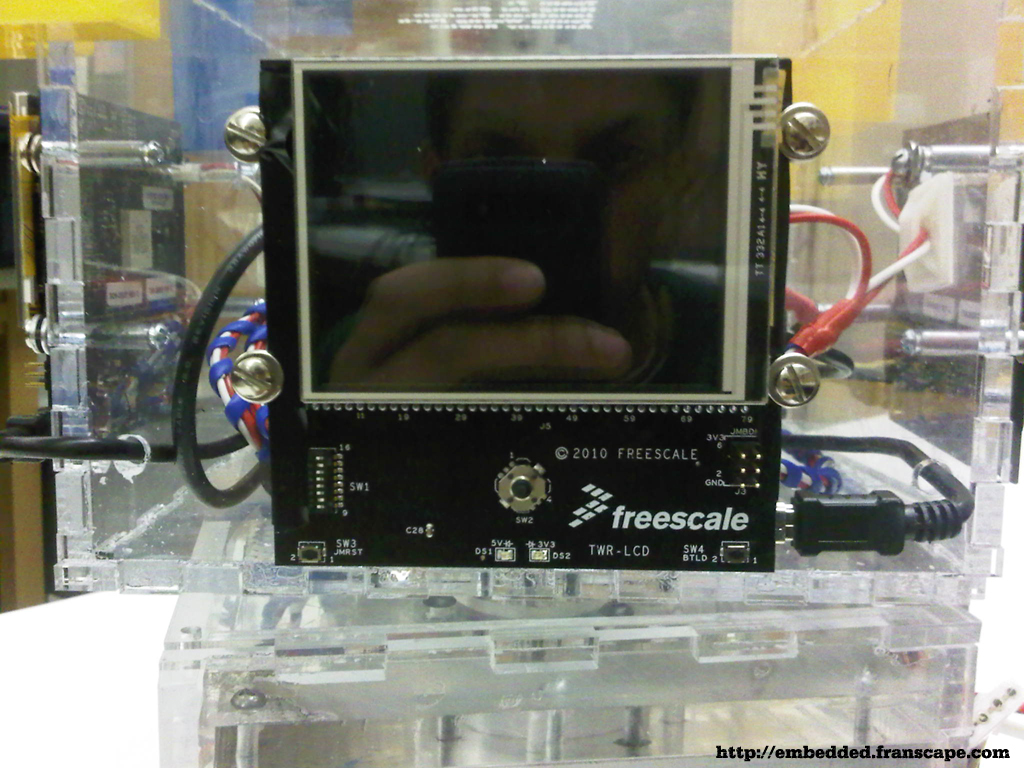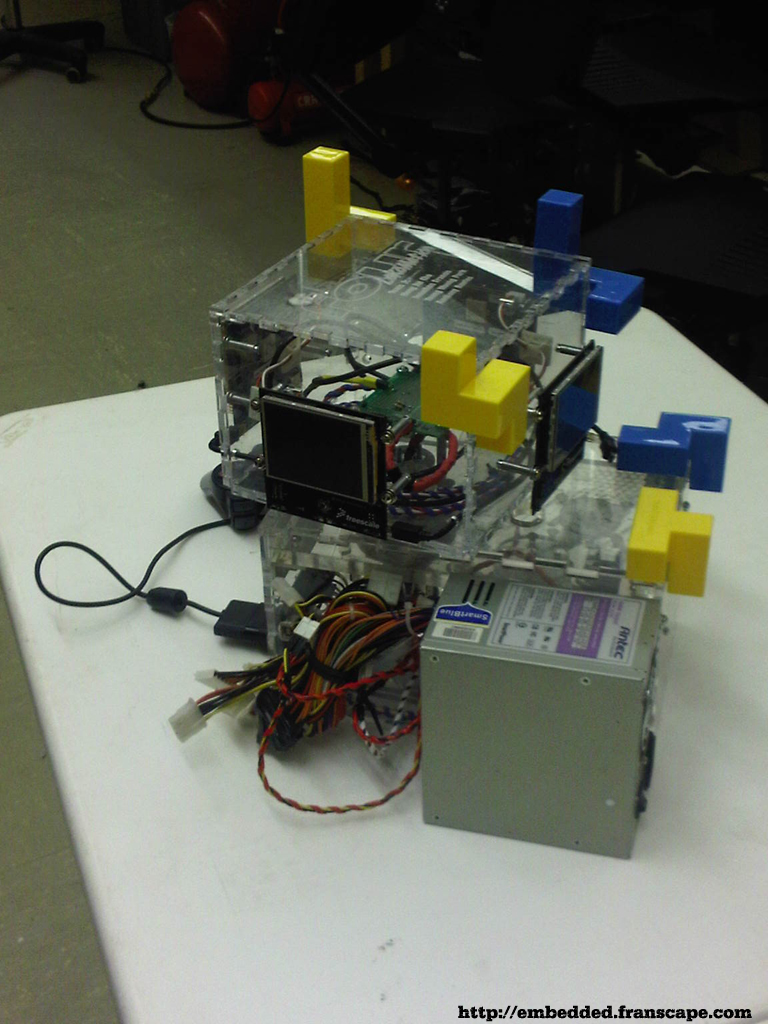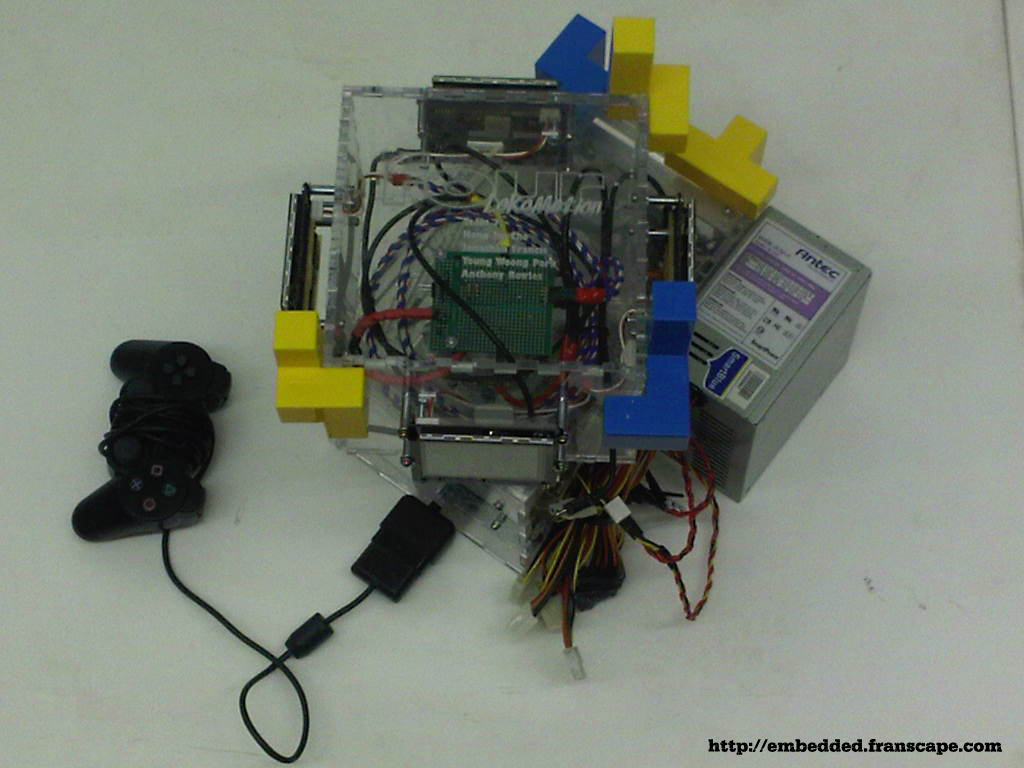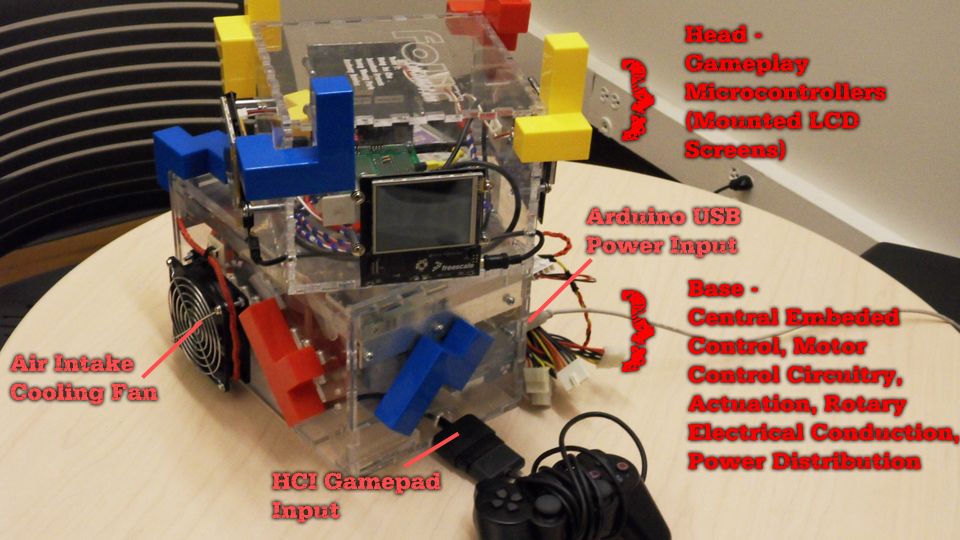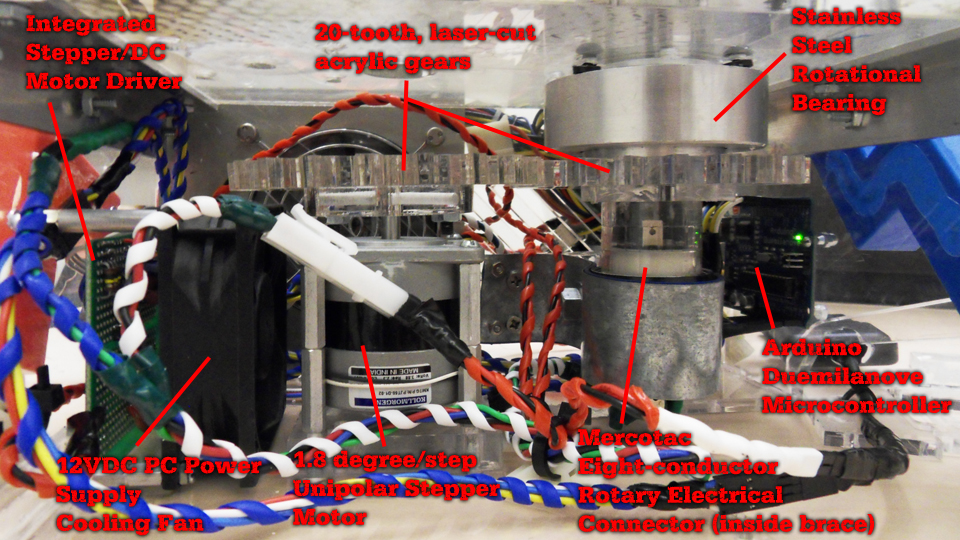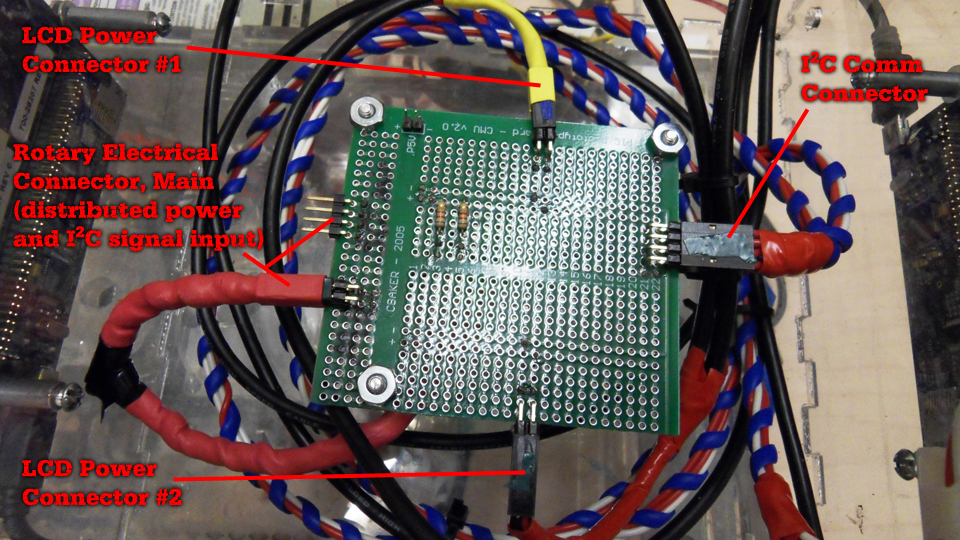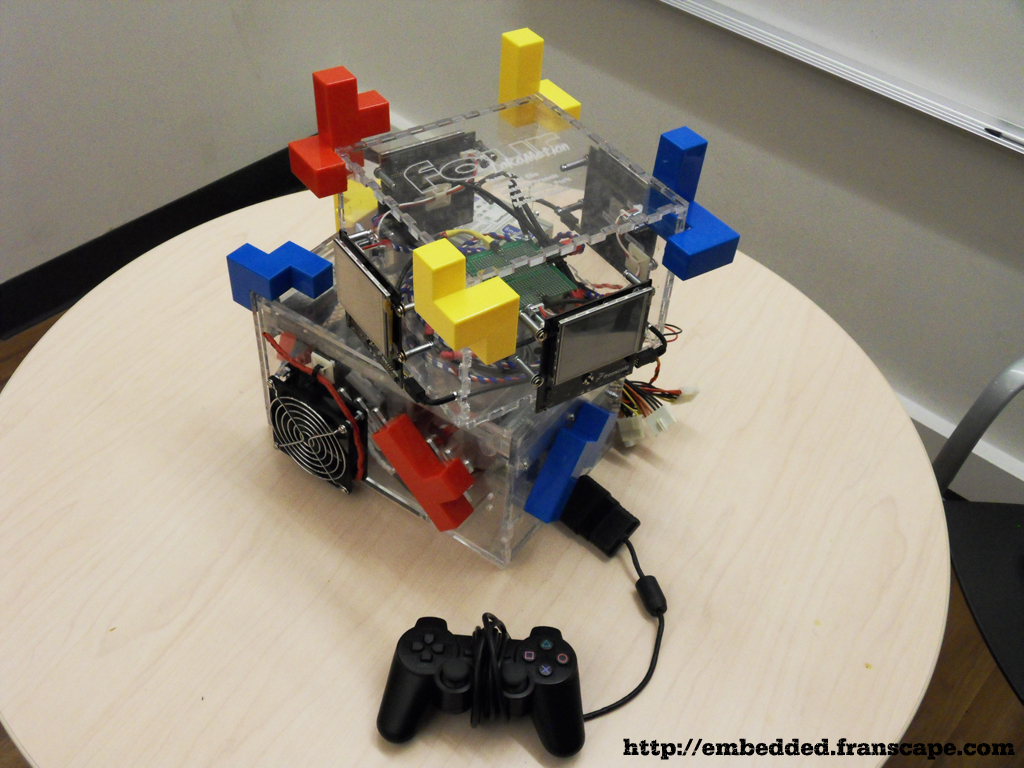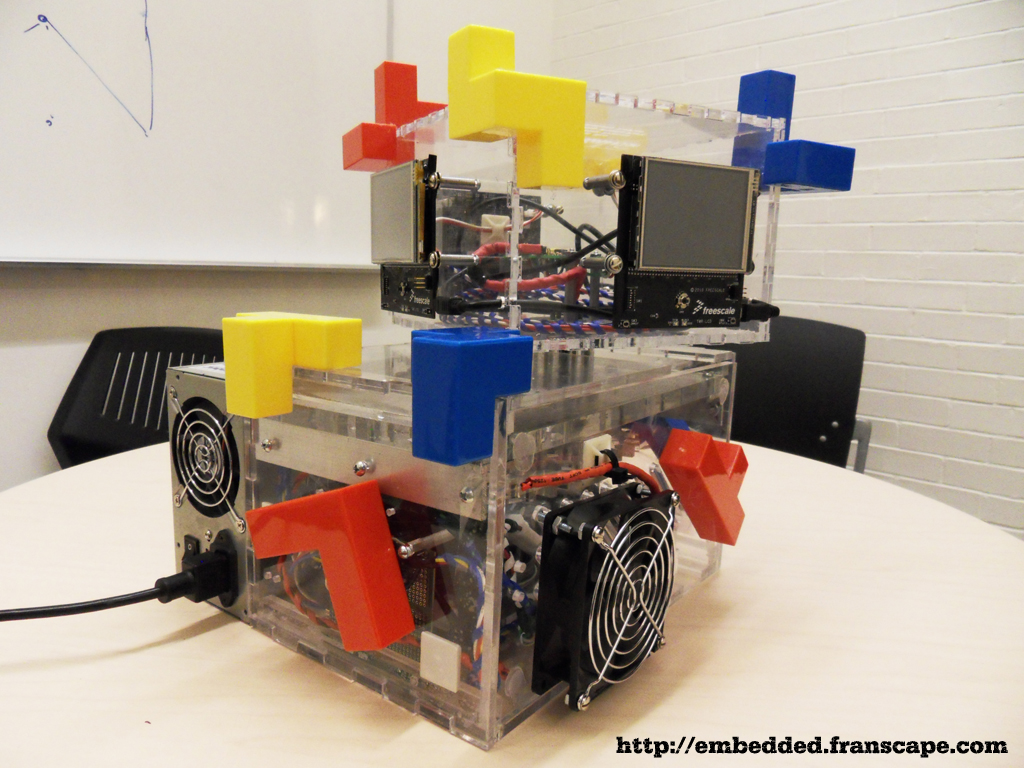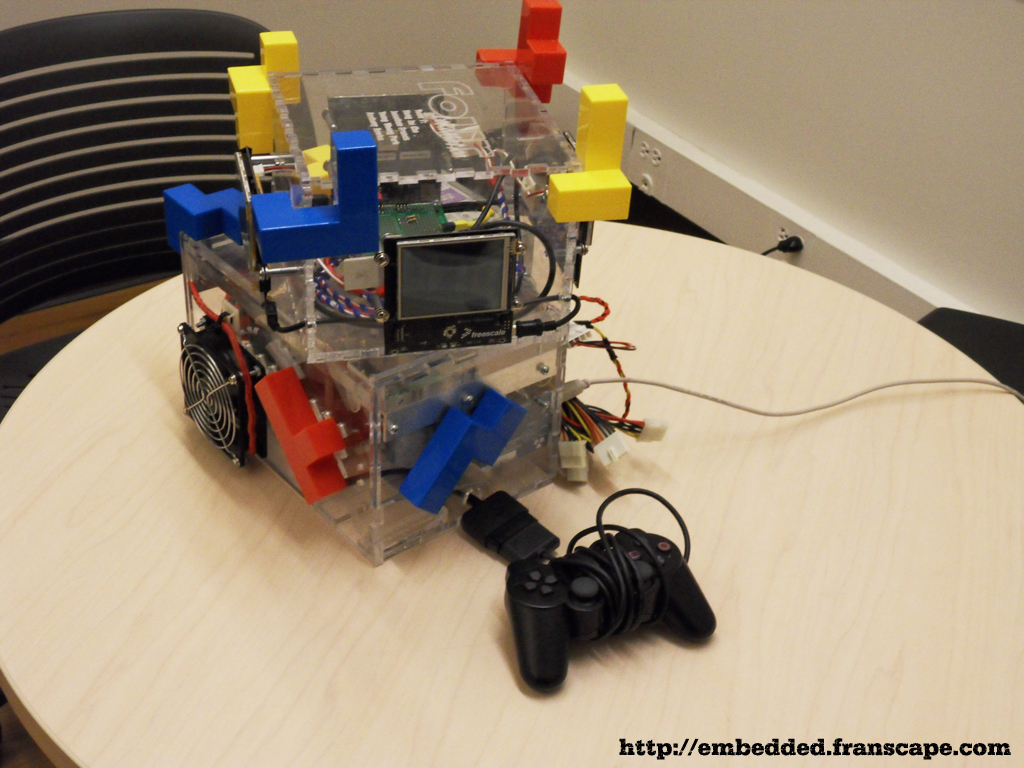-

Figure 1: System Overview (click for larger image)What if there existed an embedded arcade gaming device with a user-controlled, quad-screen interface -- capable of bringing together 1-4 users to re-live the classics or to catch a glimpse of the future of gaming? This prospect is closer than you think. Introducing: "Four-Loko Motion", in Embedded System Design. Four Loko-Motion is a gaming device with four independent screens that form a rectangular parallelepiped: In single player mode, Four Loko-Motion allows the player to jump from a screen to another with the game states maintained; in multi player mode (up to four players), players can play an interactive game, possibly swapping screens.
-
Stepper-motor actuated control system for high precision
-
Sealed, mercury-filled rotary electrical connector, for eight conductor wiring through the rotating neck/platform
- Distributed embedded system, for integrated quad-screen gameplay
Final Presentation Video
-
Stepper-motor actuated control system for high precision
Team Members & Responsibilities
Top ![]()
· Jonathan Francis (jmf1) - Electrical & Computer Engineering |
Schedule ›
Embedded software development, web development, electronics, part fabrication
· Anthony Rowles (aqr) - Electrical & Computer Engineering |
Schedule ›
Embedded software development and part fabrication
· Young Woong Park (youngwop) - Electrical & Computer Engineering |
Schedule ›
Game software-engineering and team media
· Hong Jai Cho (hongjaic) - Electrical & Computer Engineering |
Schedule ›
Part fabrication and team media

The motivation for Four Lokomotion is to create a gaming platform with a unique method of interaction. The combination of four screens and physical rotation of the device allows for new types of gameplay not currently available on the market. The use of four screens on opposite cube faces allows multiple people to participate in the gaming experience, even with a single controller, as the user playing the game can only see one screen at a time. The physical rotation of the screens requires the user to think in an additional spatial dimension, which can be incorporated into both classic and novel games.
- Hand-held Gaming Devices
-
-
PlayStation Portable
- Portable gaming device produced by Sony; essentially a miniaturized version of the PlayStation game console.
- The PSP offers a traditional console gaming experience, with the case serving as the typical "controller" and the built-in screen serving as the "television", whereas our product features a unique way of interacting with the games (multiple screens and physical rotation). The device costs approximately $170.
-
Nintendo DS
- Portable gaming device produced by Nintendo; features two screens, one with touch sensitivity, and is controlled by a combination of classic game controls and a stylus.
- The Nintendo DS line is closer to our device, as it features multiple screens and non-traditional game controls. However, gameplay is still very similar to the traditional console gaming experience, and the device is not meant to be utilized by more than one person at a time. The Nintendo DS costs approximately $130.
-
PlayStation Portable
- Digital Toys
-
-
GAME-800 Pocket Emulator
- The GAME-800 is a hand-held device designed to emulate hundreds of classic video games, with simple, intuitive controls, and one screen.
- The GAME-800 doesn't present the classic games in any unique manner like our device, but it does offer a large variety of games in a small, toy-like package, at a competitive price compared to more robust hand-helds like the PSP and DS. It also has some value-added features like an MP3 player, PDF reader, and camera. The GAME-800 costs approximately $80.
-
GAME-800 Pocket Emulator
- Arcade Games
-
-
Non-traditional arcade games like Police 911 or DDR
- No current arcade games utilize physical rotation or multiple screens in the way we envision for our device, but in general we would be competing against the arcade games that use unique forms of interaction, such as body movement or a highly customized controller. The novelty of our game system would attract attention in an arcade and this should enhance its popularity.
-
Non-traditional arcade games like Police 911 or DDR
Coming soon..
Technical Specifications / Charts
Top ![]()
-
Hardware
-
FreeScale Flexis™ 32-bit ColdFire V1 Microcontroller
- 25 MHz clock speed
- 256KB Flash, 32KB SRAM
- 47 I/O pins
- Onboard USB controller
- Cost: $60.00
-
Arduino Duemilanove Microcontroller
- 16 MHz clock speed
- 32KB Flash, 2KB SRAM, 1KB EEPROM
- 14 Digital I/O pins
- 6 Analog Input pins
- Onboard USB controller
- Cost: N/A
-
FreeScale 3.2" Graphic LCD
- 3.2" QVGA TFT LCD display with touch sensitive overlay.
- Dedicated MCF51JM microcontroller
- Cost: $99.00 (x4)
-
Mercotac Model-830 Rotary Electrical Connector
- 8-conductors
- 0-250 VAC/VDC; 2@4/6@30 (Amp Rating @240VAC)
- Max Freq. (Mhz): 100
- Cost (Paid != Retail): $50.00
- Sony PlayStation 2 Controller (Dual-Shock 2)
-
FreeScale Flexis™ 32-bit ColdFire V1 Microcontroller
-
Software
-
FreeScale eGUI Graphic LCD Driver
- Low memory footprint graphical LCD driver software
- Built-in touchscreen support
- Cost: free
-
FreeScale eGUI Graphic LCD Driver
-
Protocols
- I2C Comm Protocol
Risks / Quality Assurance / Testing
Top ![]()
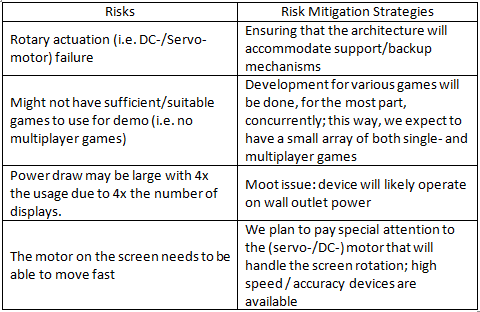
Media: Presentations, Talks, Videos
Top ![]()
· Project Proposal and Requirements: [ *.pdf, *.pptx ]
· Design & Architecture: [ *.pptx ]
· Use Cases: [ *.png ]
· Mid-semester Project Status
· Test Plan & Experimental Validation [ *.pdf ]
· Final Project Presentation Video [ (YouTube) ]
· Project Poster [ *.pptx ]

